
How One Advisor Generated 35 Leads on LinkedIn in 6 Months Without Spending a Dime on Ads

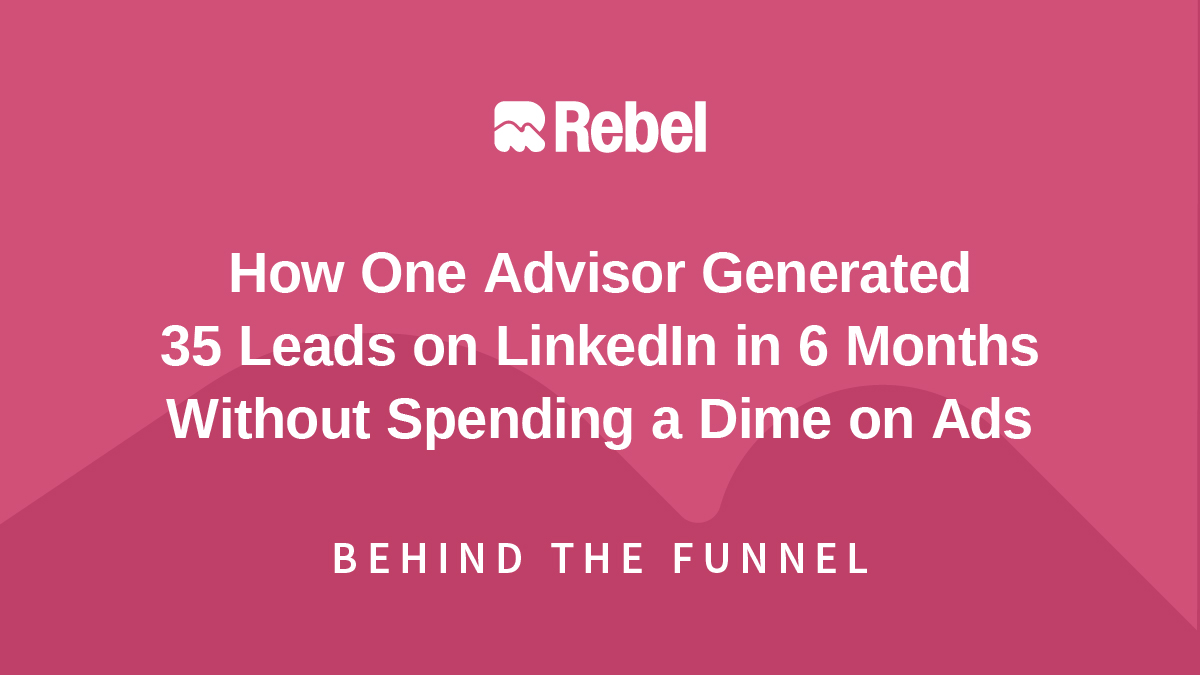
Welcome to Behind the Funnel—a series where we break down real advisor growth stories and reverse-engineer what made their marketing funnel work.
👋🏻 Meet The Advisor: Joseph D. Stabile, CFP®, ChFC, CEPA
When Joe Stabile decided to go all-in on LinkedIn, he wasn’t trying to go viral—he just wanted a consistent, scalable way to attract his ideal clients.
It took 12-18 months of testing, refining, and showing up before things started to click. But now, six months into 2025, he’s generated 35 qualified inbound leads, added thousands of targeted followers, and turned LinkedIn into his most reliable growth channel.
In this edition of Behind The Funnel, we’re sharing Joe’s exact strategy:
- What he stopped doing (and why it wasn’t working)
- What he doubled down on to get traction
- How those shifts turned LinkedIn into his top lead source
- The real numbers behind his results
- Takeaways you can apply to your own firm
Plus, you’ll also get few additional tips I shared to help him improve his funnel even further.
💬 Not Into Social Media? That’s Okay.
This isn’t a “how to use LinkedIn” post. This case study is about how Joe used focus, consistency, and niche clarity to strengthen his marketing funnel.
Even if you never post on social media, the way Joe built his funnel offers lessons that apply to all advisor’s marketing strategy.
Want all future Behind The Funnel breakdowns delivered to your inbox so you don’t miss them? Sign up for our newsletter: Attention To Assets.
📊 Quick Firm Stats
- Advisor: Joe Stabile, CFP®, ChFC®, CEPA®
- Firm Stage: Advisor for 5 years (starting in 2020)
- Team Size: 1 (solo advisor)
- Primary Niche: Self-employed millennials (ages 30–45) earning $300K+ and individuals with equity compensation
- Marketing Channel: LinkedIn
- Inbound Leads: 35+ from LinkedIn (first half of 2025)
- Client Growth Goal: 50-100 clients max
❌ What Wasn’t Working
Before 2024, Joe was active on LinkedIn but not consistent.
He posted content here and there, often getting distracted by seminars, networking, or trying to be present on too many platforms.
Despite good intentions, the results were underwhelming:
"I’d post for a few weeks, then fall off. I got maybe 5 clients total in 2024 from all my efforts."
Looking back, Joe realized he was trying to speak to everyone and his posts didn’t work because they were too generic.
"I wasn’t really speaking to anyone in particular. Once I started sharing stories that felt personal and relevant to my niche and getting specific with my examples, that’s when people started engaging."
This is one of the fundamentals of why most advisor marketing content falls flat: It’s too broad.
If your content feels like it could apply to anyone, it’s not going to connect with anyone. The goal isn’t to be liked by the masses—it’s to be unmistakably relevant to the few people you actually want to work with.
The right clients should feel like you’re speaking directly to them about the urgent and painful problems they want to solve in their finances.
Everyone else? Your content should gently turn them away.
Great marketing isn’t just about attracting the right people; it’s also about repelling the wrong people.
👉 If your content isn’t catching the attention of your ideal client, you’re likely going too broad.
✅ What Changed
At the start of 2025, Joe made a decision: He was done spreading himself thin. No more inconsistent posting on multiple channels. Seminars and events were cut from his to-do list.
He was ready to go all in on one platform he enjoyed: LinkedIn.
This is what I call “channel focus.”
Joe picked LinkedIn as his primary marketing channel and committed to:
- Posting 5–7 times per week
- Writing for a specific niche (self-employed, high-income millennials)
- Telling personal, specific stories with ultra specific content
- Focusing on the core pain points of his avatar
His shift to channel focus combined with the specificity in content and deeper storytelling is when things started to work.
In just the first six months of 2025, Joe’s LinkedIn following grew by over 3,000 people, bringing his total to 17,000.
More importantly, 35+ qualified prospects reached out because of his work on LinkedIn and about 50% of those are converting into clients.
That’s not just reach. That’s real, tangible firm growth.
Here’s what specificity looks like in action (click the "more" to read the full post):
Also, notice what is not happening here.
- There are not a ton of comments. While comments can be a good indicator, they aren’t always the sign of converting content. Qualified prospects lurk more than we realize.
- Other advisors aren’t cheering from the comments section. You need real prospective clients (not peers) seeing your content. The more other advisors engage with your posts the less likely it is to reach your ideal client. Why? LinkedIn gets confused on who your target audience is and shares it with the wrong people!
What made Joe’s strategy work is that he focused his efforts on one avatar, one channel, and one funnel.
His content was ultra-specific and highly relevant to the kinds of people he wants to help.
When we say we believe in advisor marketing should be made simple—this is exactly what we’re talking about.
However, simple is not easy. In fact, as Joe’s funnel illustrates…simple takes a lot of focus, consistency, and patience! 😅
If you’re serious about using content to drive client growth, take a page from Joe’s playbook:
- Define exactly who you want to reach (nail your avatar)
- Show up consistently on one platform (choose one)
- Share content that speaks to real, meaningful problems (consistently)
- Build a fully functioning funnel (top, middle, and bottom)
📈 The Results In 2025
Since doubling down this year, Joe has:
- Grown from 14,000 to over 17,000 followers on LinkedIn
- Generated 35+ inbound leads in the first 6 months of 2025 (and counting)
- A close rate of ~50% (he’s attracting qualified prospects)
- Attracted leads who already understand his value and specialty
Even more impressive: he’s done all of this with no ads, no automations, and no team managing content.
Let’s dive deeper into what’s working and why.
💡 What’s Working (and Why)
Lots of advisors post on LinkedIn.
Joe grew by over 3,000 followers and brought in 35+ leads because he did something most don’t: he executed with clarity and focus.
Here's what made it work:
1. A Clear, Narrow Niche Communicated Clearly
Joe’s profile banner and headline make it clear who he helps:
"Modern Financial Advice for Millennials (30-45) Earning $300K+ Who Are Self-Employed or Have Equity Comp"
This specificity is a reflection of his clarity around his ideal client which then flows into his content and marketing funnel.
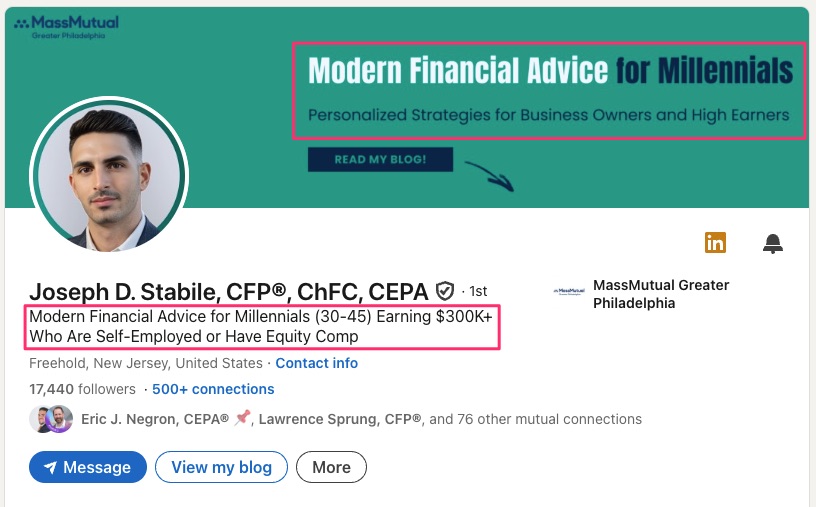
2. Story-Driven, Specific Content
Instead of generic tips like “Why You Should Contribute to your Roth IRA,” Joe shares detailed scenarios with specific numbers (adjusted to pass compliance requirements, obviously).
The specificity and story-driven nature of this content is a key element of creating converting content on all platforms.
“Telling a story with a character people can relate to—that’s what I’ve found actually gets people to read the post.” - Joseph Stabile
3. Consistency Over Complexity
He shows up daily on LinkedIn—not to impress the algorithm, but to stay top of mind with his ideal clients. The result is that his audience feels like they already know him before the first call.
He said he often gets comments on his Linkedin content:
“Every time I’m out, someone tells me, ‘I feel like I’ve been catching up with you on LinkedIn.’ That’s how I know it’s working.”
Consistency with marketing sounds simple but it’s outrageously hard. You’ll notice most of Joe’s posts aren’t fancy. They are text based without images. What he does do is share a consistent message that speaks to meaningful problems his ideal client wants to solve.
4. Filling the top of his funnel by connecting with his ideal client
Every week, Joe manually connects with 100 people who match his ideal client profile—founders, C-suite executives, or professionals at companies like SpaceX and Google.
He intentionally does this outreach manually, here’s why:
“I used an automated messaging tool for almost three years and saw hardly any results at all. At the start of 2025, I stopped using it and decided to do everything manually. It felt like I just needed to be human on LinkedIn and connect with people. Going manual feels slower, but it actually works.” - Joseph Stabile
A key step of a social media funnel is making sure your content reaches the right people (this is your top of the funnel).
With LinkedIn, this often looks like using Sales Navigator (a paid tool) to search for your ideal client and connect with them.
This is why it is very important to understand who you want to reach and optimize your profile and content to speak directly to them so you have a higher chance they will accept your request or follow your account if your content hits their feed.
🛠 If He Wanted to Level Up, Here’s What I’d Recommend
Joe’s LinkedIn funnel is already working—but with a few tweaks, he could further refine his funnel and focus.
Here are a few opportunities I saw after reviewing his LinkedIn approach and funnel:
Right now, Joe straddles two avatars: business owners and high-earners with equity comp. I recommend he picks one if he wants to take his funnel to the next level. Why?
The more narrow his niche, the sharper his message will be.
While his content is narrow, he could go deeper. For example, I am a business owner. If I followed Joe on LinkedIn:
- Half of his content (anything equity comp) would not interest me.
- This content misalignment also means I would not engage with it and his reach could be impacted.
- With two audiences, it’s harder to build a lead magnet to drive email signups. Does he create an offer for millennial business owners (me 👋🏻) or equity comp folks (👨🏻💻)?
Here’s how I would adjust his profile header copy:
For practice management purposes, a more narrow client base will make it easier to grow and charge more too. Joe could still serve high-earners in tech with equity comp if he wanted to but he will only market to millennial business owners.
Given that Joe only wants to find 50-100 incredible clients to serve, a more narrow niche is not only do-able but recommended.
His current call-to-action in his banner and button in his profile header points visitors to his blog.
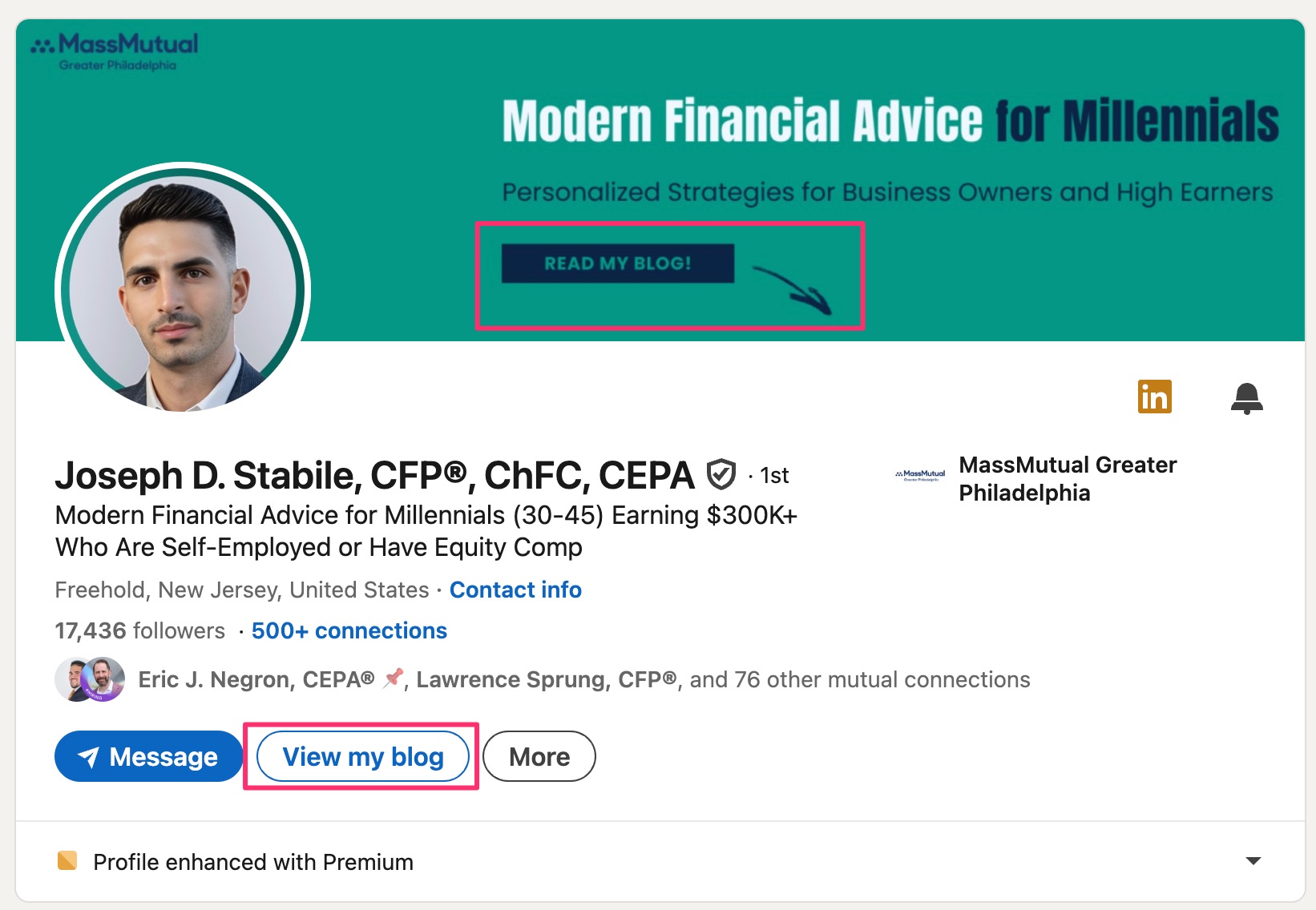
A more strategic move would be to offer a niche-specific lead magnet (e.g. “7 Ways Business Owners Making $300K+ Accidentally Increase Their Taxes”) and start building an email list.
Social media can be a great channel to build top of funnel awareness for your firm. And, technically it can also do the heavy lifting in the middle of the funnel, nurturing leads over time.
However, I get nervous when I see advisors building large followings on any platform without intentionally starting to move a small percentage to somewhere they own (often their email list).
Driving social followers to your email list is a tradeoff. You’ll need to:
- Do it in a way that honors the platform (posting links to “join your newsletter” is often not an effective approach).
- Accept that we’re aiming for a percentage of followers not all followers (2-5% is a great start)
- Test. You may have to try different offers to build an approach that works. Email growth from social media is hard but not impossible.
- Be patient with the slow trickle. We’re playing this game over years, not the instantaneous timespan you’re used to with social.
One final note about why converting some of your social followers to email subscribers is important:
Only 3% of your potential market is actively prepared to make a purchase.1
If you move social followers to your email list, you’ll have an easier chance staying top of mind (email is more predictable than social algorithms) and we can build trust overtime until they are actively looking to hire an advisor.
Usually, I don’t focus on email growth (middle of funnel) until your reach is working well (top of funnel) though. You may spread yourself too thin.
Even though Joe is seeing great traction with his LinkedIn marketing funnel, he asked me about incorporating video into his strategy:
“I’ve been thinking about adding video for awhile. I’ve tried to film but struggled to get videos working and honestly, I hate doing it. Do you think I should add video? And if so, what is a good approach to adding video into my marketing strategy?”
Lean in advisors, because I’m about to save you a lot of money and stress:
If you do not enjoy a marketing activity, it is not a good choice for you.
You do not need social media to grow your practice.
You do not need video to grow your practice.
All channels work!
You do need to choose ONE channel you genuinely enjoy and set the others aside so you can build a funnel marketing funnel that converts clients consistently and predictably.
Instead, here’s what I recommended for Joe:
Don’t add video, add LinkedIn carousels.
Why?
The medium he prefers to educate people with is writing. Leverage his writing skills to add carousels. Then, hire a designer to turn key posts into scrollable slides.
This would help him stand out in-feed and improve dwell time (a metric that when improved could increase his post reach).
There is a time when it makes sense to add more marketing channels but most advisors aren’t there yet and very few get there.
Joe has reached what I like to call the “cross over point” in his lead flow.
- If you don’t have enough lead flow, your call booking process can be more “open” with less restrictions.
- Once you’re getting too many leads or too many unqualified leads, it’s time to add friction to your call booking process.
Resource: Hear more about when and how to add more friction to your call booking process in our episode, “Top Advisor Website Questions (Part 1): Should You Share Your Fees & More.”
Right now, the booking process on his website is a manual contact form.
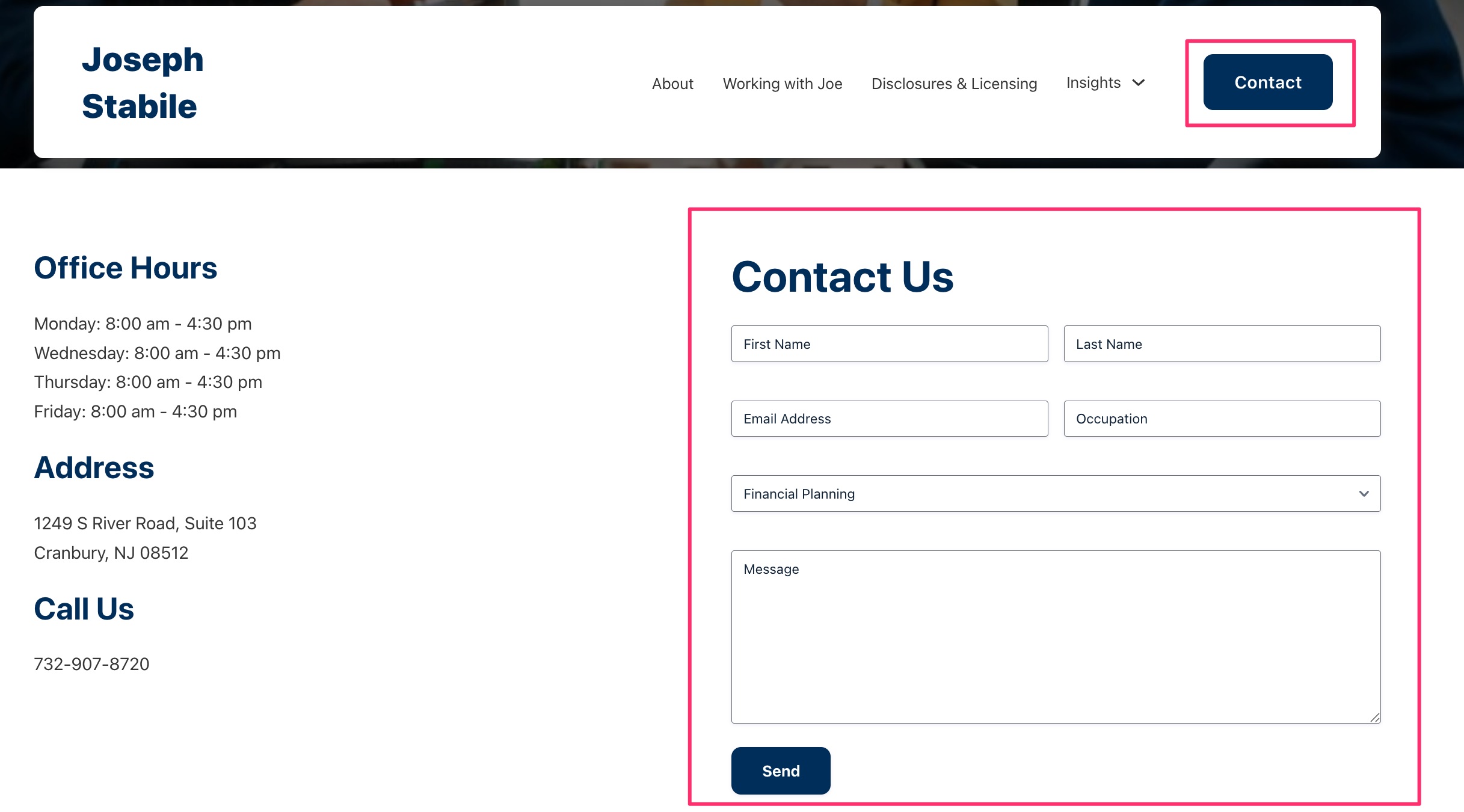
While he is closing new qualified clients, the visibility he is getting on LinkedIn is naturally sending him a few folks who don’t meet his minimums.
Here’s what I recommended for Joe:
First, automate his call scheduling process. The manual form is clunky. He may also be missing a few quality prospects with this flow too. I’d also add a few details on what to expect on the first call on this page.
Second, I’d use a survey tool like JotForm or Typeform to create logic that does not allow anyone unqualified to book a call with him.
For the logic add questions like:
- What is your gross income per year? (to filter by income)
- What are your current total investable assets (to filter by assets)
Add a dropdown that lists income or asset ranges. Make sure the first choice is below your minimum. For example, if your assets minimums are $750,000 your ranges could look like this:
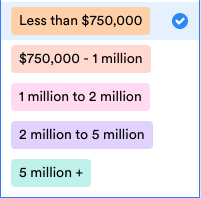
Everyone below your minimum is re-routed to a standalone page with resources. They are not given access to your calendar to book an introductory call.
(Another option is to make your minimum the floor so you don’t have to build the logic routing at all. The approach you take depends on the visibility you want. If you want to see your form leads who were not qualified to understand lead flow, use logic).
This automated call booking process (with the appropriate amount of friction) will streamline booking, prequalify leads, and save Joseph time.
This is how you remove unqualified leads on your calendar.
If you’re there, enjoy the cross over point! This is an exciting milestone for your firm.
💬 Takeaways for Other Advisors
If you're an advisor looking to turn online attention into real firm growth, here’s what you can learn from Joe (even if you never post on social media):
- Align your marketing to your strengths. Joe’s funnel is tailored to how he enjoys educating (writing) and on a channel he enjoys (LinkedIn). Yours should be too. If you hate it, don’t do it. Period.
- Pick one platform and master it instead of trying to be everywhere. When you spread your time across multiple channels, it’s easy to stay busy without getting results. Joe focused on LinkedIn, learned what worked, and built a repeatable system. Then, the results started to happen. Mastery over multi-tasking is a key to results in marketing.
- Get radically specific about who you serve. If your niche is unclear, your content will always feel generic. The more specific your message, the more it will connect. Even if you serve multiple niches, narrow your focus to one avatar per marketing funnel. This focus will improve your content clarity.
- Teach through storytelling. Case studies and examples with hypothetical numbers help prospects see their problems (and solutions!) in your content. This kind of content takes a lot of work, you can’t just throw it together.
- Simplify your funnel. Joe didn’t overcomplicate his LinkedIn marketing strategy. He used content to build awareness and trust (top and middle of funnel) with his ideal client. Then, when they were ready, a small percent booked a call (bottom of funnel).
- You’ll always feel the pull to do more. Even though Joe is seeing success on LinkedIn he felt the pull to add video, a medium he doesn’t enjoy. Focus is a competitive advantage. We found a way to level up his strategy (adding carousels and email marketing) without diluting his focus or changing his preferred medium.
Want more advisor marketing funnel breakdowns like this?
👉 Join our newsletter: Attention to Assets
We break down real advisor funnels, share what's working (and what’s not), and how to apply it to your advisory firm.


